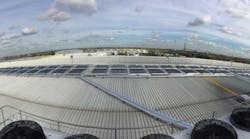Solar thermal technology isn’t new under the sun. For centuries, it’s been utilized for heating water. But the integration of solar thermal into the HVAC refrigeration cycle is new – and it offers significant energy savings.
The introduction of variable load HVAC/R systems (VRF, inverter, staged, screw, digital scroll, etc.) has made the integration possible. While you may have heard over the last decade of some unsuccessful applications of thermal cooling, a new approach has succeeded where others failed. This article will provide an overview of the technology and show documented energy savings of this approach reducing energy consumption of HVAC/R usage by 30-65%.
What is solar thermal cooling?
To many, the idea of adding heat to the air conditioning/refrigeration cycle appears counterproductive. But we must remember that most air conditioning systems and chillers are essentially heat pumps that cool buildings by moving heat out of them. The vapor compression cycle used in most heat pumps is driven by a high-temperature and/or high-pressure refrigerant. To generate these high temperatures and pressures, electricity is used to drive a compressor. A solar thermal cooling system uses solar energy to reduce the electricity needed for the process.
The diagram below shows the typical vapor compression cycle supported by a solar thermal panel. The thermal collection unit is installed on the discharge side (hot gas side) of the compressor. Free solar energy is injected into this hot refrigerant gas, increasing the kinetic energy of the molecules and the velocity and temperature of the refrigerant. The higher temperature of the refrigerant gas increases the delta temperature (Delta T) between the condenser coils and the outside air, which increases the heat flow out of the system. The increased heat flow means the gas reaches the equilibrium point (the conversion of the refrigerant from gas to liquid) earlier within the condenser coil, which also improves the effectiveness of the heat transfer and conversion to liquid.
CYCLE OF REFRIGERATION WITH SOLAR THERMAL HEAT
As the refrigerant passes from the condenser toward the evaporator, the heat pump’s internal monitoring components will recognize that more than enough of the liquid refrigerant is of sufficient quantity and quality to allow the evaporator to be effective. With this excess cooling capability, the compressors can then slow down or stage off. The energy savings begin as the solar energy “substitutes” for some of the energy formerly used by the compressor(s).
Benefits of solar thermal cooling include the following:
- Sustainability and reduction in greenhouse emissions due to using the sun’s free energy.
- Adaptability for retrofits and new installs – These systems can be used on new or existing HVAC systems that have variable flow capability and compressors able to slow or stage down.
- Forward compatibility – When replacing an existing HVAC/R system, the solar thermal components can just be re-piped into the new system with minor adjustments.
- Internal rates of return (IRR) of 15-65% on investments prior to any tax, utility, and/or other incentives.
- Scalability – No system is too large or too small.
- No moving parts and small footprint
- Reduction in overall HVAC/R energy consumption of 30-65%, even when including evenings and winter seasons.
- Peak demand reduction – The hotter the sun, the more efficient the system becomes. The highest efficiencies are achieved during peak hours, when demand savings may be available.
The three case studies below illustrate the benefits of solar thermal heating for HVAC.
CASE STUDY #1: SOLAR THERMAL COOLING RETROFIT FOR AN HVAC SYSTEM SERVING A COMPUTER SERVER ROOM
A computer room at an East London Vinegar facility in South Africa had two identical 12,000-BTU variable-drive air conditioning units. One of the units was retrofitted with a solar thermal kit. Both units were monitored to capture like-for-like comparisons. The graph below shows an independent energy comparison in which the retrofitted unit had a 76% reduction in energy consumption.
Even at night time, efficiencies over 25% were found to occur. When the sun is no longer on the solar panel, it cannot bump up the energy in the refrigerant. However, it doesn’t need to do so because the outside air temperature also drops significantly at night. As a result, the refrigerant does not need to be as hot to reject heat into the atmosphere. An adequate Delta T between the refrigerant and the outside air still exists. Due to the lower nighttime outside temperature, the solar panel acts to extend the heat rejection surface area of the condenser. As you see in the blue/red graph, even at night there are savings up to 25% although on a much lower load.
CASE STUDY #2: GAS STATION
Another case study was completed at a gas station in Ireland, where extensive pre-and post-retrofit monitoring was done on the HVAC systems serving the refrigerated cases. Throughout the study, it was determined that the refrigeration system’s average daily savings in electricity consumption were running at 41.5% compared to levels before the installation of the solar thermal technologies. (See bar chart below.)
CASE STUDY #3: PUBLIC LIBRARY
A 60-ton HVAC system at the public library in Fort Myers Beach, FL, was recently retrofitted with solar thermal. The savings (partial year of data) was greater than 30%.
Most of this article’s information and its data were contributed by James Mezzenga of SolX Energy. Feel free to reach out to James with any questions or comments at 239-834-7529 or [email protected]. For more information and case studies, visit www.solxenergy.com
---------------------------------------------------------
Eric A. Woodroof, Ph.D., is the Chairman of the Board for the Certified Carbon Reduction Manager (CRM) program and he has been a board member of the Certified Energy Manager (CEM) Program since 1999. His clients include government agencies, airports, utilities, cities, universities and foreign governments. Private clients include IBM, Pepsi, GM, Verizon, Hertz, Visteon, JP Morgan-Chase, and Lockheed Martin. In August 2014, he was named to the Association of Energy Engineers (AEE) Energy Managers Hall of Fame.


